Angling 101: Getting Started in Fishing
Angling 101: Getting Started in Fishing
By Steve Huber
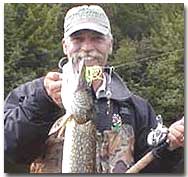 With the Internet, the flow of information that is passed back and forth is absolutely amazing. Unfortunately, the amount of misinformation is equally amazing. I spend a great deal of time on various fishing message groups and I'm constantly astonished at the amount of misinformation that is being passed as the gospel according to Bubba. Equally amazing is some of the equipment that clients show up with when they hire me. Mis-matched or unsuited for the task at hand would be an understatement. With the Internet, the flow of information that is passed back and forth is absolutely amazing. Unfortunately, the amount of misinformation is equally amazing. I spend a great deal of time on various fishing message groups and I'm constantly astonished at the amount of misinformation that is being passed as the gospel according to Bubba. Equally amazing is some of the equipment that clients show up with when they hire me. Mis-matched or unsuited for the task at hand would be an understatement. Now, the kids have been pestering you to take them fishing, you'd really like to get everyone involved in a wholesome, family oriented sport. You decide, "What the heck, let's do it!" Everyone piles in the family truckster and down to the local Super-Mega-Mart you go. Trooping into the sporting goods department, there's a bewildering array of rods and reels in all different shapes, sizes and prices…what do you get? Hopefully by the time you're done with this article, you'll have a little better handle on the subject. Hey, I realize that just like any other subject, there are many different opinions on what is best when it comes to fishing. I realize that, heck I like to fish spinnerbaits more than anything; others maybe like crankbaits or soft plastics. We all can go out and catch fish, does that mean that one is right and another is wrong? Nope, just a difference of opinion. But, what does frost my fritters is blatant bad advice. So if you're thinking about getting into fishing, here's a little "intro to fishing equipment." Choosing The Right Reel... There are three basic types of freshwater fishing tackle. Spincasting, Spinning and Baitcasting. What I'm going to do is cover the three different types separately, citing the appearance, common uses, pros and cons. Spincasting The first type is spincasting, sometimes called "Closed Face" reels. This type of fishing tackle is some of the first that most new anglers see. It is typically an inexpensive type of equipment but hey, like all fishing tackle, you can get some fairly expensive spincast reels. Spincast reels have a pushbutton line release for casting and an enclosed "nosecone" where the line comes out of the reel. Spincasting reels are mounted on top of the rod and are used primarily by casual anglers, usually fishing for small to medium sized fish. 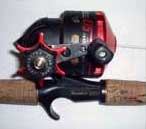 Spincast rods typically are 5 to 6 feet in length, have a short, "pistol grip" and small eyes. These rods are usually fairly limber in action and light in weight. Spincast equipment is fine for casting medium weight lures/bait. These don't usually work very well for heavy-duty fishing but some larger spincast reels have been designed for catfishing and are gaining some acceptance. Spincasting reels typically are the easiest to learn but they have some failings. Typically, reels of this type don't have much line capacity, rendering them unsuitable for fishing that requires a lot of line or really heavy pound test. They also usually don't have a very good drag system and the gears in these reels are usually cast plastic or white metal. The gear ratio for the line retrieve is pretty low also, making it difficult to work a lure that requires any amount of speed. If casting accuracy is required, it is difficult with spincast equipment. Spincast rods typically are 5 to 6 feet in length, have a short, "pistol grip" and small eyes. These rods are usually fairly limber in action and light in weight. Spincast equipment is fine for casting medium weight lures/bait. These don't usually work very well for heavy-duty fishing but some larger spincast reels have been designed for catfishing and are gaining some acceptance. Spincasting reels typically are the easiest to learn but they have some failings. Typically, reels of this type don't have much line capacity, rendering them unsuitable for fishing that requires a lot of line or really heavy pound test. They also usually don't have a very good drag system and the gears in these reels are usually cast plastic or white metal. The gear ratio for the line retrieve is pretty low also, making it difficult to work a lure that requires any amount of speed. If casting accuracy is required, it is difficult with spincast equipment. Spincast wouldn't be my first choice for fishing for salmon or muskies. These reels are easy to use, inexpensive to buy and might be a good choice if you're not sure how much fishing you're going to do. The better quality reels are fine for typical panfishing and casual weekend bobber watching but if you think that you're going to get fairly serious about fishing, you might want to consider the next category. Spinning 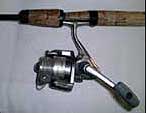 Spinning tackle is possibly the single most popular type of tackle. You can find spinning tackle anywhere from tiny, teacup sized ultra-light reels, willow wand rods and spider web thin lines all the way up to "Mongo sized" surfcasting tackle that will take on just about any size fish that swims the ocean. However, what most people use this type of tackle for is general, all around fishing or finesse fishing. Spinning tackle is possibly the single most popular type of tackle. You can find spinning tackle anywhere from tiny, teacup sized ultra-light reels, willow wand rods and spider web thin lines all the way up to "Mongo sized" surfcasting tackle that will take on just about any size fish that swims the ocean. However, what most people use this type of tackle for is general, all around fishing or finesse fishing. Spinning rods are usually more limber than baitcasting tackle. This limberness is one of the things that makes spinning excellent for casting light lures or bait, much more so than either spincasting or baitcasting. The other thing that allows spinning equipment to cast light lures far is the design of the reel. The line is allowed to peel off the spool on a cast, unimpeded by either the nosecone of spincast reel or the friction of a turning baitcast reel's spool. Spinning rods come in various lengths. I've seen spinning rods from 4 ½ foot ultralights up to 11 foot surfcasting rigs. However, these are the extremes, most spinning rods in use around here are between 6 and 7 feet. The line capacity of spinning reels is much higher than that of spincast reels so fishing for salmon or trout is possible. "Most" spinning reels have a much smoother drag too, something that is required for finesse fishing and for long running fish. However, the qualities that make spinning great for finesse fishing also somewhat limit where it can be used. I use spinning tackle primarily for open water fishing or for smaller fish. Panfish, walleye, smallmouth/largemouth bass (NOT in heavy cover) and all open water species are chased with spinning tackle. When I am going to be "pounding the junk", that's when I reach for baitcasting tackle. Baitcasting 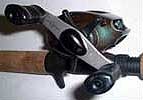 Baitcasting tackle is probably the most difficult to learn. But, once learned, is probably the most used of serious anglers. Watch any bass tournament or muskie "fisherperson" when you're out on the lake. You'll see that 99% of the time, they're using baitcast equipment. Baitcasting tackle is probably the most difficult to learn. But, once learned, is probably the most used of serious anglers. Watch any bass tournament or muskie "fisherperson" when you're out on the lake. You'll see that 99% of the time, they're using baitcast equipment. Baitcasting is used anytime heavy cover is going to be targeted. It's ability to handle heavy line, lures and fish is unmatched as is its strength to weight ratio. Baitcast equipment is NOT meant to be used with light lures; anything under ¼ oz. would be better fished with spinning tackle. Baitcasting tackle is the goto tackle when big fish and big lures meet thick, nasty cover. Also, because you control the cast with your thumb, pinpoint accuracy is possible. Once you become proficient with a baitcast reel, it's possible to drop a lure in a 6-inch circle at 50 feet, with hardly a ripple on the water. That kind of accuracy and "touch" is rarely possible with spincasting or spinning tackle. Baitcasting rods too come in varying lengths and look somewhat like a spincasting rod. But that's where all similarity ends. Baitcasting rods typically have a lot more backbone than the other types of rods. It's this backbone that allows you to muscle a fish from thick weed growth or away from timber. It's also this backbone that allows you to cast heavyweight lures, work big jerkbaits and twitch crankbaits effectively. Try these tactics with most spinning tackle and you'll be exhausted. Putting It All Together.... O.K., now that you know the differences, what does it all mean? You're probably saying, "All right Steve, this info is great, but now what?" Well, buckaroo, let me finish. Here's the big wrap-up that will tie everything together. Bear with me. It kind of goes like this, DON'T EVER buy anything that is shrink-wrapped on a sheet of cardboard. I guarantee that you will be frustrated, disappointed and thoroughly ticked off before the first day is done. If you're going to go just a time or two each season, fishing for whatever is biting, mostly watching and waiting for a bobber to go down, then get a 5 ½ - 6 foot light action spincast rod and a matching reel, take the line off that comes with the reel (most spincast reels come prepackaged with junk line) and re-fill the reel with a quality 8 pound test monofilament line. Buy some assorted terminal tackle and other fishing equipment and you're in business. But, you used to fish as a kid but haven't touched a rod in years. You know that you like to fish but until recently, you haven't had time. You want to catch bluegills and perch most of the time but you'd like to maybe try bass fishing or chase a walleye or two. You know that you don't want the ol' Snoopy Catchem Kit but aren't sure what to get. My suggestion to you is to go find a 6 - 6 ½ foot spinning rod. There are many quality, mid-priced fishing rods available today. Look for names like Berkely, Shimano and Mitchell for decent mid-priced rods. A little higher on the spectrum are rods like St. Croix, Fenwick, Falcon, All-Star, higher yet, you start getting into G. Loomis prices and your "spousal unit" starts pricing lawyers. A medium sized spinning reel to hang on the rod is needed. You want to make sure that the rod and reel are matched for size and balance. You'll know if they're balanced if you put the reel on the rod, and rest the rod, just in front of the reel foot on your index finger. The rod should balance out, if the rod tips forward, you've picked too small of a reel, tip backwards and you've got to pick out a smaller reel. Personally, I really like the Shimano Sahara 1000 reel for 99% of my walleye fishing. It's smooth, lightweight, durable and has a good drag system. Spool this package up with 6 or 8 pound premium mono and you're in business for 90% of the fishing that most people will do. But what about that remaining 10%? Well, guess what, you're in baitcasting territory now my friend. If you want to pick on toothy critters (muskie or pike) or start chasing bass in heavy cover, this is specialized tackle. For most bass and pike fishing, medium bass tackle will work well. At this point, you have to decide whether you want one of the newer, low profile type reels or do you want the traditional round reel. There are factions in the fishing world that will swear that one type or the other is the best. To be perfectly honest, quality reels can be found in both round and low profiles. One of the reasons to get a low profile reel is if you have small hands. Many of my smaller framed clients really like this type of reel. It seems to fit their hand better and makes a day of fishing easier. I like to palm the reel, cupping the reel in my left hand instead of just holding onto the rod handle. I've learned how to do this comfortably with either style, but then again, I do fish more than 150 days a year! Other anglers think that the round reels are stronger, smoother, more traditional, or whatever. From an engineering standpoint, they are both equally strong and smooth. It's just a personal preference. So, which style is best for you? I don't know, my advice is to fish with someone who has both, try them and get whichever one feels better in YOUR hands. Good bass/pike reels range in price from $54.95 up to several hundred dollars. For the low profile reels, I like the Shimano Chromica, Coriolis and Curado. Round reels that have held up well for me in the past are the Shimano Corsair and the Ambassaduer 5500 series. 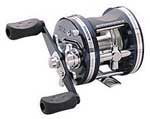 Once you get into muskie reels, there are two reels that are industry leaders. The first is the venerable Ambassaduer 6500 and the other is the Shimano Calcutta 400. I've been using a lower priced Shimano, the Corsair 400 and it's done well. There were some complaints about this reel when it was first introduced. These complaints resulted in Shimano re-designing the reel to work out the bugs. I've heard no complaints on the new series of Corsairs. Once you get into muskie reels, there are two reels that are industry leaders. The first is the venerable Ambassaduer 6500 and the other is the Shimano Calcutta 400. I've been using a lower priced Shimano, the Corsair 400 and it's done well. There were some complaints about this reel when it was first introduced. These complaints resulted in Shimano re-designing the reel to work out the bugs. I've heard no complaints on the new series of Corsairs. Rod selection can be daunting. Look in some of the major sporting goods catalogs and you'll see a wide array of baitcasting rods. There's specialty rods for crankbaits, jigs, plastic worms, flippin', walleye rods, bass rods, muskie rods…. What's a guy to get? I like a 6 - 7 foot fast action, medium weight graphite rod. I prefer the straight cork grip with a "Two Handed" butt section, a graphite reel seat and a cork foregrip. Again, just like the spinning rods, there are a wide variety of prices and sizes. For general fishing, the rod that I just described will get you just about everything that swims in the Midwest. I've caught walleyes crankbaiting, bass and pike on just about every lure available and even muskies. This rod and an Ambassaduer 5500 or Shimano Coriolis is a good place to start your baitcasting journey. I hope that somewhere along the line, all of this made some sense to you. Getting started in fishing can be a daunting task, but if you use this article as a general guideline, you should be all right. But if you do find that you're really getting into fishing, one or two rods won't get you very far. You'll soon find out that your first rod, while fun to use at first, won't quite work in certain situations. That means that you have to go out and get another, then you'll be wandering down the rod aisle and something else will catch your eye, then you have to get a reel to fit the rod, then "There's this really great sale Hon…." Before you know it, you're like me, just about every time I go out fishing, I'm literally traveling with at least 19 rods. "Man, I love this sport!" If you have any questions, feel free to fire me an e-mail at [email protected] and I'll do my best to help you out. Until next time, see ya.
This article courtesy of Steve Huber and Lake-Link.com. Visit Lake-Link at http://Lake-Link.com
|
